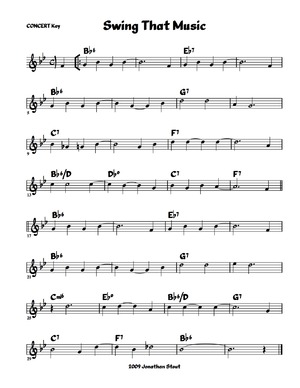Video: "Swing that Music"
As suggested by my friend Kim Clever, I'm going to start doing semi-regular videos, mostly just jamming over some backing tracks, although I'll hopefully be able do some more concerted things as well. I'm still working on getting a permanent video solution set up - my wife had to shoot these by hand.
Apologies if you've already seen this via Facebook, but this was taken right around Christmas and it's just me playing my new ES-150 through my EH-160. It was hard to get any kind of useful volume level out of the 160 using my other guitars, but there's something about the response of the pickup that matches the amp perfectly. At least for playing around the house, the volume level is more than enough. I've found it particularly sweet sounding, and especially "Charlie" sounding, when the amp is cranked, but the volume knob is rolled mostly down.
"Swing That Music" is a tune I never get to play. It's a signature tune for our trumpet player Jim Ziegler, and something he usually reserves to do with his own band, the Swingsations. The times I'd encountered it, I was just stuck with a lead sheet from a hand-written Dixieland Fakebook, and because the way it was written, I always messed up the changes. Specifically, the ABAC structure of the tune is straight forward enough, but the lead sheet was written in a way that made it hard to pickup the C section at the right spot on the page. Suffice it to say, it's not the lead sheet's fault I didn't just learn the tune instead. When I finally got around to learning, I found the changes give a lot of nice stuff to work with.
The backing track can be found on my soundcloud - www.soundcloud.com/campusfive - along with many other songs. Heres a PDF of the lead sheet: Swing That Music (PDF)
The A section is just two bars each: I - IV7 - I - VI7 (Bb / Eb7 / Bb / G7). Like "Undecided" and "Sing You Sinners" as well as many other tunes, the I-IV7 movement is chance to either play a lick that has a D natural in it against the I chord, and then play something that changes the note to a Db over the IV7 chord. Alternatively it can be nice to play a lick without a D in it over both chords and see how that static lick feels different over each chord. The I - VI7 move is another standard one. I find the melody emphasizing D, A and G over the G7 chord to be particularly telling about how to approach that change. For many years, I seized on the voice leading of Bb notes over the Bb chord to a B natural over the G7 chord, and emphasized that change. However, I don't find that as many well-written song melodies contain that movement, and I think that should be telling. While mechanically running through changes and highlighting the notes that have changed from chord-to-chord technically "works", that doesn't necessarily mean those notes are "pleasing" or make a good sounding melody.
The B strain is just a II7 - V7 (C7-F7), followed by a I - iii˚ - II7 - V7 turnaround (Bb-Db˚-C7-F7). I've seen the last II chord there be both min7 and dominant7, and realistically you kind of make it work either way, melodically.
Following the second A strain, is a C strain. Part of what makes the tune interesting, and part of what always messed me up, is that the G7 resolves to a C MAJOR type chord the first time, but to a C MINOR type chord the second time. Also, the changes here move quickly, and if you're thinking mechanically, it can be more difficult than it looks.
The C changes go ii - iv˚ - I - VI7 (Cm-Eb˚-Bb-G7). While it's written here as an Eb dimished, I think that functionally it's interchangeable with an Eb minor. The ii-iv-I change is a common one found is several tunes, such as Limehouse Blues, China Boy, Avalon. Charlie Christian often made a post of emphasizing iv-I resolutions, even placing them where the band did not play them. You can either highlight the voice leading, in this case G-Gb-F, or avoid those notes and let chords resolve underneath. Either way, watch out for the G7 chord, because even I'd threaded the changes up to that point, I'd usually forget about it, and be emphasizing a Bb note over the G7 by mistake. After the ii-iv-I, it's just a VI7-II7-V7-I back cycle. Anyway, the video is just a single take blowing over the changes. Hope something here is useful. Cheers.
